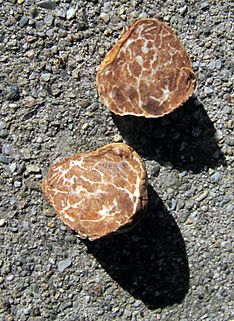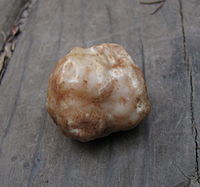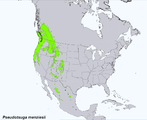- Tuber oregonense
-
Tuber oregonense 
Scientific classification Kingdom: Fungi Division: Ascomycota Class: Pezizomycetes Order: Pezizales Family: Tuberaceae Genus: Tuber Species: T. oregonense Binomial name Tuber oregonense
Trappe, Bonito & Rawlinson (2010)Tuber oregonense Mycological characteristics 
glebal hymenium 
hymenium attachment is not applicable 
lacks a stipe 

spore print is blackish-brown
to brown
ecology is mycorrhizal 
edibility: choice Tuber oregonense, commonly known as the Oregon white truffle, is a species of edible truffle in the genus Tuber. Described as new to science in 2010, the North American species is found on the western coast of the United States, from northern California to southern British Columbia west of the Cascade Range. A mycorrhizal fungus, it grows a symbiotic association with Douglas fir. It overlaps in distribution with the closely related T. gibbosum, but they have different growing seasons: T. oregonense typically appears from October through March, while T. gibbosum grows from January to June. The fruit bodies of the fungus are roughly spherical to irregular in shape, and resemble small potatoes up to 5 cm (2.0 in) in diameter. Inside the truffle is the gleba, which is initially white before it becomes a marbled tan color. The large, often thick-walled, and strongly ornamented spores are produced in large spherical asci. The truffle is highly prized for its taste and aroma. Attempts to cultivate the truffles in Christmas tree farms have been successful.
Contents
Taxonomy and phylogeny
Tuber gibbosum
Tuber bellisporum
Tuber castellanoi
Tuber oregonense
Tuber sphaerosporum
Tuber anniae
Tuber borchii
Tuber irradians
Phylogeny of Tuber species in the Gibbosum clade, based on ribosomal DNA sequences.[1] The species was first officially described and named in a 2010 Mycologia publication,[1] although Tuber oregonense had previously been used as a provisional name (as Tuber oregonense Trappe & Bonito)[2] in a number of field guides and other popular publications for several years.[3][4][5] The type specimen was collected from Benton County, Oregon on 3 February, 2007 along U.S. Route 20 in Oregon.[1]
The specific epithet oregonense derives from the name Oregon and the Latin suffix -ense (relating to), in reference to western Oregon being its central region of abundance.[6] The fungus is commonly known as the Oregon white truffle. Truffle authority James Trappe was initially intending to name the species as a variety of Tuber gibbosum (i.e., as Tuber gibbosum var. oregonense)[7] before molecular analysis revealed that it was clearly genetically distinct enough to warrant being designated a separate species.[1]
T. oregonense is part of the Gibbosum clade of the genus Tuber. Species in this clade have "peculiar wall thickenings on hyphal tips emerging from the peridial surface at maturity."[1]
Description
The fruit bodies of T. oregonense are hypogeous (growing in the ground), typically 0.5–5 cm (0.20–2.0 in) broad (although specimens up to 7.5 cm (3.0 in) have been recorded). Smaller specimens are spherical or nearly so, and have random furrows; larger specimens are more irregular in shape, lobed and deeply furrowed. Young fruit bodies have a white peridium, as the truffle matures it develops red to reddish-brown or orangish-brown patches; with age it becomes orange-brown to reddish-brown overall and often develops cracks on the surface. The peridium is 0.2–0.4 mm thick, and the surface texture ranges from relatively smooth to covered with tiny "hairs" that are more dense in the furrows, and more scattered on the exposed lobes. The gleba is solid, in youth the fertile tissue is whitish and marbled with mostly narrow, white, hypha-stuffed veins that emerge throughout the peridium to its surface. In maturity, the fertile tissue is light brown to brown from the color of the spores, but the marbling veins remain white. The odor and flavor of the flesh are mild in youth, but soon become strong, pungent and complex, or "truffly".[1]
The spores are ellipsoid to somewhat spindle-shaped with narrowed ends, and light brownish in color. The size of the spores varies depending upon the type of asci in which they develop: in one-spored asci they measure 42.5–62.5 by 17.5–30 µm; in two-spored asci they are 32.5–50 by 15–25 µm; in three-spored asci they are 27.5–45 by 15–25 µm; in four-spored asci they are 25–38.5 by 13–28 µm; in five-spored asci 28–34 by 22–25 µm (all sizes excluding surface ornamentation). The spore walls are 2–3 µm thick and are covered with a honeycomb-like (alveolate) network. The cavities of the honeycomb typically have five or six sides, and the corners form spines that are 5–7 µm tall by 0.5 µm thick. A "microreticulum" appears in some spores when the light microscope objective is focused on the optical cross section but not on the spore wall surface, or on scanning electron microscopy micrographs of the surface. Young asci range in shape from spherical to broadly ellipsoid to ovoid (egg-shaped) or pyriform (pear-shaped); sometimes the base of the ascus is narrowed like a stipe,and measures up to 15 by 7 µm. Mature asci are spherical to broadly ellipsoid or misshapen from the pressure of crowded spores within. They are hyaline (translucent), thin-walled, 60–85 by 65–75 µm, 1–4-(occasionally 5)-spored, and astipitate (without a stipe) at maturity.[1]
The peridiopellis (the cuticle of the peridium) is 200–300 µm thick plus or minus 80 µm of tightly interwoven hyphae that are 3–5 (sometimes up to 10) µm broad. The cells are short and have nearly hyaline walls that measure 0.5–1 µm thick; the interior veins emerge through the peridium the cells and often form a localized tissue of rounded cells up to 12 µm broad. The degree to which the surface is covered with fine "hairs" is variable; these hairs are made of tangled hyphae and emergent thin-walled hyphal tips 2–5 µm in diameter, some even and smooth, some with granulated surfaces and some with moniliform walls (resembling a string of beads) that are irregularly thickened by hyaline bands that are 0.5–2 µm wide. The subpellis (the tissue layer immediately under the pellis) is abruptly differentiated from the pellis, 150–220 µm thick, and comprises interwoven, nearly hyaline, thin-walled hyphae 2–10 µm wide with scattered cells up to 15 µm wide. The gleba is made of hyaline, thin-walled, interwoven hyphae that are 2–7 µm broad with scattered cells that are inflated up to 15 µm.[1]
Similar species
Tuber oregonense closely resembles Tuber gibbosum, which grows in the same habitats, but may be distinguished by the structure of its peridium, and differences in spores size and shape. Further, Tuber gibbosum grows from January to June.[8]
Edibility
Tuber oregonense is a choice edible species. Its odor has been described as ""truffly", a complex of garlic, spices, cheese, and "indefinable other essences"; the fungus is prized after by commercial truffle harvesters and consumers for its intense fragrance.[2] Because they grow in the topsoil and needles, they are considered to have a more "floral" and "herbal" flavor profile than related European truffles.[9] Some individuals have had success in growing the truffles in Christmas tree farms in Oregon.[4] The species has been commercially harvested in the Pacific Northwest since the 1980s.[7] The Oregon Truffle Festival has been held in Eugene yearly since 2006 to coincide with the maturing of the truffle in late January; it features activities such as cultivation seminars, truffle hunting excursions, winery tours, fine truffle dining at local restaurants, a marketplace, and public lectures.[10]
Ecology, habitat and distribution
Like all Tuber species, T. oregonense is mycorrhizal. The fungus grows west of the Cascade Mountains from the southern Puget Sound region of Washington, south to southwestern Oregon at elevations from near sea level up to 425 m (1,394 ft) in pure stands of Pseudotsuga menziesii forests up to 100-years-old, or Pseudotsuga mixed with Tsuga heterophylla, Picea sitchensis or Alnus species. It is often found in Christmas tree plantations as young as five years. Fruit bodies are produced from September through the middle of March.[1] The fungus is an important component of the diet of Northern flying squirrels, and comprises the majority of their diet at certain times of the year.[11]
References
- ^ a b c d e f g h i Castellanoi G, Trappe JM, Rawlinson P, Vilgalys R. (2010). "Improved resolution of major clades within Tuber and taxonomy of species within the Tuber gibbosum complex". Mycologica 102 (5): 1042–57. doi:10.3852/09-213.
- ^ a b Trappe et al., (1997). pp. 106–107.
- ^ Miller HR, Miller OK. (2006). North American Mushrooms: a Field Guide to Edible and Inedible Fungi. Guilford, Connecticut: Falcon Guide. p. 531. ISBN 0-7627-3109-5. http://books.google.com/books?id=zjvXkLpqsEgC&pg=PA531.
- ^ a b Ammirati J, Trudell S. (2009). Mushrooms of the Pacific Northwest: Timber Press Field Guide. Portland, Oregon: Timber Press. pp. 298–99. ISBN 0-88192-935-2.
- ^ Hall et al. 2007, p. 78.
- ^ Trappe et al. (2007), p. 123.
- ^ a b Lefevre CK, Pilz D, Trappe JM, Molina A (2001). "Tuber gibbosum and Leucangium carthusianum: ecology, harvesting and marketing". Actes du 5ème Congrès International Science et Culture de la Truffe (Proceedings of the Vth International Congress on the Science and Cultivation of Truffles and other Edible Hypogeous Mushrooms). Aix-en-Provence, France: Fédération Franc aise des Trufficulteurs. pp. 4.214–4.217. http://www.natruffling.org/orwhttrf.htm.
- ^ Trappe et al., (1997). pp. 102–103.
- ^ Mutić A. (1 November 2010). "Digging treasured truffles". Wine Enthusiast Magazine. http://www.winemag.com/Wine-Enthusiast-Magazine/Web-2010/Digging-Top-Truffles-in-Unexpected-Places/. Retrieved 2010-06-16.
- ^ "Oregon Truffle Festival". http://www.oregontrufflefestival.com. Retrieved 2011-07-01.
- ^ Volk T. (1997). "Tuber gibbosum, the Oregon white truffle". Tom Volk's Fungus of the Month. University of Wisconsin-La Crosse, Department of Biology. http://botit.botany.wisc.edu/toms_fungi/jan97.html.
Cited texts
- Trappe JM, Trappe M, Evans FB. (2007). Field Guide to North American Truffles: Hunting, Identifying, and Enjoying the World's Most Prized Fungi. Berkeley, California: Ten Speed Press. ISBN 1-58008-862-7.
- Hall IR, Brown GM, Zambonelli A. (2007). Taming the Truffle: the History, Lore, and Science of the Ultimate Mushroom. Portland, Oregon: Timber Press. ISBN 0-88192-860-7.
External links
- Tuber oregonense in MycoBank.
- North American Truffling Society Side-by-side comparison of T. oregonense and T. gibbosum
Categories:- Tuber (fungus)
- Truffles (fungi)
- Fungi of North America
- Fungi described in 2010
- Oregon culture
Wikimedia Foundation. 2010.




